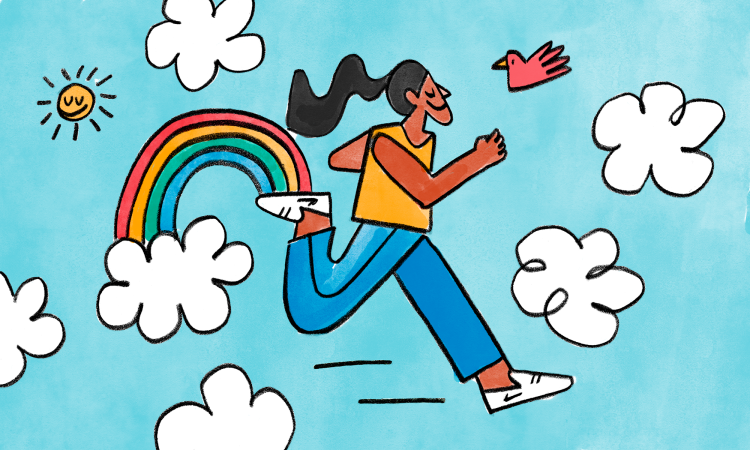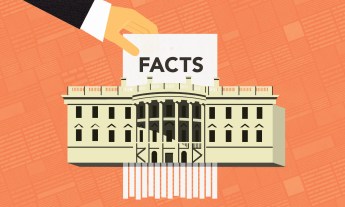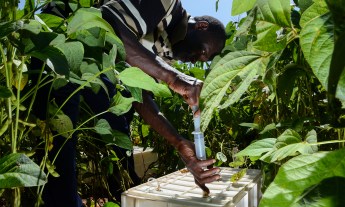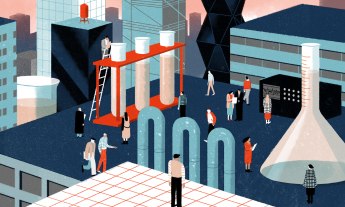
The runner’s high is often held up as a lure for reluctant exercisers, described in terms that can strain credulity. In 1855, Scottish philosopher Alexander Bain described the pleasure of a fast walk or run as “a species of mechanical intoxication” that produces an exhilaration akin to the ancient ecstatic worship of Bacchus, the Roman god of wine. Trail runner and triathlete Scott Dunlap sums up his running high this way: “I would equate it to two Red Bulls and vodka, three ibuprofen, plus a $50 winning Lotto ticket in your pocket.”
Others liken it to a spiritual experience. In The Runner’s High, Dan Sturn describes tears streaming down his face during mile seven of his morning jog. “I flew closer and closer to the place mystics and shamans and acidheads all try to describe. Each moment became precious. I felt simultaneously all alone and completely connected.”
But this side effect is not exclusive to running. Bliss can be found in any sustained physical activity, whether that’s hiking, swimming, cycling, dancing or yoga. However, the high emerges only after a significant effort. It seems to be the brain’s way of rewarding you for working hard. Why does such a reward exist?
The latest theory about the runner’s high makes a bold claim: Our ability to experience it is linked to our earliest ancestors’ lives as hunters, scavengers and foragers. Researchers like biologist Dennis Bramble and paleoanthropologist Daniel Lieberman (watch his TEDxWilmingtonWomen Talk on dopamine) have hypothesized that the neurochemical state which makes running gratifying may have originally served as a reward to keep early humans hunting and gathering.
David Raichlen, an anthropologist at the University of Southern California, was familiar with the idea that natural selection favored traits that allowed humans to run. His own work in graduate school helped establish the theory (including a 2005 academic paper title “Why is the human gluteus so maximus?”) Still, he was stymied by the problem of motivation. A skeleton that makes running easier is not enough to create an endurance athlete. What would make early humans willing to exert so much effort? If anything, humans seem predisposed to conserve energy. It’s a caloric risk to travel all day, using up energy reserves in the hopes of catching something big.
Raichlen, a recreational runner, began to think about the runner’s high. Maybe early humans got high when they ran so they wouldn’t starve. Such a neuro-reward would have to do two things: Relieve pain and induce pleasure. Scientists have speculated that endorphins are behind the runner’s high, and studies show that high-intensity exercise causes an endorphin rush.
But Raichlen had in mind another candidate, a class of brain chemicals called endocannabinoids. These are the same chemicals mimicked by cannabis or marijuana. Endocannabinoids alleviate pain and boost mood, which fit Raichlen’s requirements for rewarding physical labor. And many of the effects of cannabis are consistent with descriptions of exercise-induced highs, including the disappearance of worries or stress, a reduction in pain, the slowing of time and a heightening of the senses.
Earlier research hinted that exercise might trigger a release of these chemicals, but no one had ever documented it during running. So Raichlen put regular runners through treadmill workouts of differing intensities. Before and after each run, he drew blood to measure endocannabinoid levels. Walking slowly for 30 minutes had no effect, nor did running at maximum effort. Jogging, however, tripled the runners’ levels of endocannabinoids — and the elevation in endocannabinoids correlated with the runners’ self-reported high.
Raichlen’s hunch was correct: The runner’s high is a buzz. Why did jogging increase endocannabinoids, but walking slowly and running at an exhausting pace did not? Raichlen speculates that our brains reward us for exercising at intensities similar to those used for hunting and foraging two million years ago.
If that is true, then natural selection should have rewarded other animals who hunt or scavenge in similar ways. Canines, for example, evolved to chase prey over large distances. Raichlen put pet dogs on the treadmill, too, to see if they got a high. As a comparison group, Raichlen used pet ferrets. Wild ferrets are nocturnal, hunting sleeping mammals but also toads, bird eggs and other sources unlikely or unable to lead them in a wearying chase.
Natural selection had no reason to reward ferrets for physical endurance — and apparently it didn’t. After 30 minutes of jogging, the dogs showed increased blood levels of endocannabinoids. The ferrets, despite trotting on the treadmill at an impressive speed of 1.9 miles per hour, did not.
What does all this mean for today’s recreational exerciser? For one, it suggests that the key to unlocking the runner’s high is not the physical action of running but its continuous moderate intensity. Scientists have documented a similar increase in endocannabinoids from cycling, walking on a treadmill at an incline, and outdoor hiking. If you want the high, you just have to put in time and effort.
There’s no objective measure of performance you must achieve, no pace or distance you need to reach that determines whether you experience an exercise-induced euphoria — you just have to do something that is moderately difficult for you and stick with it for at least 20 minutes. That’s because the runner’s high isn’t a running high; it’s a persistence high.
Persistence is key to experiencing a high while exercising, but maybe that’s not the best way to think about it. We don’t persist so we can get a neurochemical reward; the high is built into our biology so that we can persist. Natural selection has endowed us with a way to chase our goals and keep going even when it’s hard.
For many, the experience of persevering is part of what gives movement meaning and what makes the experience rewarding. This is the less heralded but perhaps most lasting side effect of the persistence high: You get to experience yourself as someone who digs in and keeps going when things get tough.
Neuroscientists describe endocannabinoids as the “don’t worry, be happy” chemical. Areas of the brain that regulate the stress response, including the amygdala and prefrontal cortex, are rich in receptors for endocannabinoids. When endocannabinoid molecules lock into these receptors, they reduce anxiety and induce a state of contentment. Endocannabinoids also increase dopamine in the brain’s reward system, which further fuels feelings of optimism.
As it turns out, the chemistry of a runner’s high also primes us to connect. In a 2017 review of how the endocannabinoid system works in the brain, scientists identified three things that reliably amp it up: cannabis intoxication, exercise and social connection. The three psychological states most strongly linked to low levels of endocannabinoids? Cannabis withdrawal, anxiety and loneliness.
Endocannabinoids aren’t just about not worrying and being happy; they are also about feeling close to others. Higher levels of them increase the pleasure you derive from being around other people. They also reduce the social anxiety that can get in the way of connecting. Giving rats an endocannabinoid blocker makes them less interested in socializing with other rats. In mice, it makes new mothers neglect their pups.
A runner’s high does the opposite: It helps us bond. Many people have told me they use running as an opportunity to connect with friends or loved ones. I’ve heard from people who rely on a daily workout to be more caring parents or partners. As one runner notes, “My family will sometimes send me out running, as they know that I will come back a much better person.” One study found that on days when people exercise, they report more positive interactions with friends and family. When spouses exercise together, both partners report more closeness later that day, including feeling loved and supported.
When I came across the research linking endocannabinoids with social connection, I thought about something anthropologist Herman Pontzer had told me about how early humans adapted to a changing landscape and how running is not the only factor that helped them survive. “If you had to pick one behavior that marks the beginning of hunting and gathering, that is the game changer,” he said. “It’s sharing.”
Hunting and gathering is a division of labor. Some members of the group go out hunting, while others forage for plants. “You bring those together at the end of the day, and you share and everyone has enough to eat,” Pontzer said. Groups who were better at sharing were more likely to survive, and natural selection started favoring not just traits that enhance physical endurance, like longer leg bones, but also traits that encourage within-group cooperation.
By priming you to connect, the runner’s high should also make sharing the spoils with your tribe more rewarding. An experiment at the Sapienza University of Rome suggests that physical activity can have this effect. Participants played an economic game that required contributing money to a communal pool. The more they contributed, the more all parties would benefit. Participants who exercised for 30 minutes before playing the game shared more than when they played the game without exercising first.
Whether chasing down dinner, pushing a stroller up a hill or running errands for a neighbor, we can take joy in the effort. And the more physically active you are, the more rewarding these experiences become.
One of the ways that regular exercise changes your brain is by increasing the density of binding sites for endocannabinoids. Your brain becomes more sensitive to any pleasure that activates the endocannabinoid system; it can take in more joy. This includes the runner’s high but it also includes social pleasures, like sharing, cooperating, playing and bonding. In this way, regular exercise may lower your threshold for feeling connected to others — allowing for more spontaneous feelings of closeness, companionship and belonging, whether with family, friends or strangers.
At first glance, the runner’s high seems an unlikely antidote to social isolation. Yet the neurobiological reward that kept our ancestors from starving may now save us from a more pressing modern need: loneliness.
Excerpted with permission from the new book The Joy of Movement: How Exercise Helps Us Find Happiness, Hope, Connection, and Courage by Kelly McGonigal. Published by Avery, an imprint of Penguin Random House, LLC. Copyright © 2020 by Kelly McGonigal.
Watch her TED Talk now:















